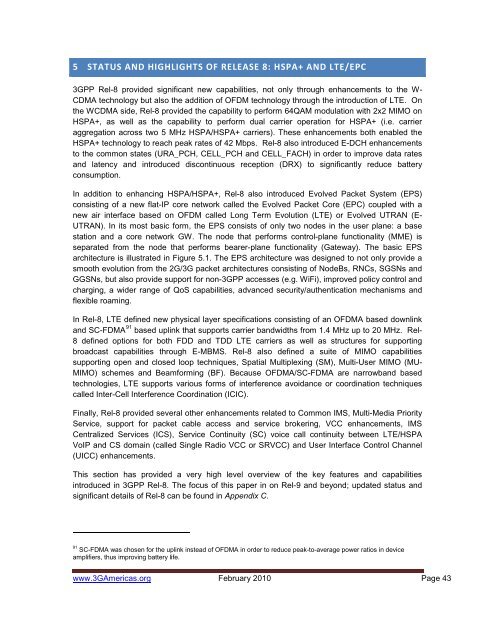UMTS: Alive and Well - 4G Americas
UMTS: Alive and Well - 4G Americas
UMTS: Alive and Well - 4G Americas
You also want an ePaper? Increase the reach of your titles
YUMPU automatically turns print PDFs into web optimized ePapers that Google loves.
5 STATUS AND HIGHLIGHTS OF RELEASE 8: HSPA+ AND LTE/EPC3GPP Rel-8 provided significant new capabilities, not only through enhancements to the W-CDMA technology but also the addition of OFDM technology through the introduction of LTE. Onthe WCDMA side, Rel-8 provided the capability to perform 64QAM modulation with 2x2 MIMO onHSPA+, as well as the capability to perform dual carrier operation for HSPA+ (i.e. carrieraggregation across two 5 MHz HSPA/HSPA+ carriers). These enhancements both enabled theHSPA+ technology to reach peak rates of 42 Mbps. Rel-8 also introduced E-DCH enhancementsto the common states (URA_PCH, CELL_PCH <strong>and</strong> CELL_FACH) in order to improve data rates<strong>and</strong> latency <strong>and</strong> introduced discontinuous reception (DRX) to significantly reduce batteryconsumption.In addition to enhancing HSPA/HSPA+, Rel-8 also introduced Evolved Packet System (EPS)consisting of a new flat-IP core network called the Evolved Packet Core (EPC) coupled with anew air interface based on OFDM called Long Term Evolution (LTE) or Evolved UTRAN (E-UTRAN). In its most basic form, the EPS consists of only two nodes in the user plane: a basestation <strong>and</strong> a core network GW. The node that performs control-plane functionality (MME) isseparated from the node that performs bearer-plane functionality (Gateway). The basic EPSarchitecture is illustrated in Figure 5.1. The EPS architecture was designed to not only provide asmooth evolution from the 2G/3G packet architectures consisting of NodeBs, RNCs, SGSNs <strong>and</strong>GGSNs, but also provide support for non-3GPP accesses (e.g. WiFi), improved policy control <strong>and</strong>charging, a wider range of QoS capabilities, advanced security/authentication mechanisms <strong>and</strong>flexible roaming.In Rel-8, LTE defined new physical layer specifications consisting of an OFDMA based downlink<strong>and</strong> SC-FDMA 91 based uplink that supports carrier b<strong>and</strong>widths from 1.4 MHz up to 20 MHz. Rel-8 defined options for both FDD <strong>and</strong> TDD LTE carriers as well as structures for supportingbroadcast capabilities through E-MBMS. Rel-8 also defined a suite of MIMO capabilitiessupporting open <strong>and</strong> closed loop techniques, Spatial Multiplexing (SM), Multi-User MIMO (MU-MIMO) schemes <strong>and</strong> Beamforming (BF). Because OFDMA/SC-FDMA are narrowb<strong>and</strong> basedtechnologies, LTE supports various forms of interference avoidance or coordination techniquescalled Inter-Cell Interference Coordination (ICIC).Finally, Rel-8 provided several other enhancements related to Common IMS, Multi-Media PriorityService, support for packet cable access <strong>and</strong> service brokering, VCC enhancements, IMSCentralized Services (ICS), Service Continuity (SC) voice call continuity between LTE/HSPAVoIP <strong>and</strong> CS domain (called Single Radio VCC or SRVCC) <strong>and</strong> User Interface Control Channel(UICC) enhancements.This section has provided a very high level overview of the key features <strong>and</strong> capabilitiesintroduced in 3GPP Rel-8. The focus of this paper in on Rel-9 <strong>and</strong> beyond; updated status <strong>and</strong>significant details of Rel-8 can be found in Appendix C.91 SC-FDMA was chosen for the uplink instead of OFDMA in order to reduce peak-to-average power ratios in deviceamplifiers, thus improving battery life.www.3G<strong>Americas</strong>.org February 2010 Page 43
















